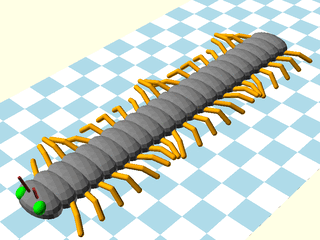Metachronal Rhythm on:
[Wikipedia]
[Google]
[Amazon]
 A metachronal rhythm or metachronal wave refers to wavy movements produced by the sequential action (as opposed to synchronized) of structures such as
A metachronal rhythm or metachronal wave refers to wavy movements produced by the sequential action (as opposed to synchronized) of structures such as
Cilia
Mathematical model of millipede gaits
Animal locomotion Waves Articles containing video clips
 A metachronal rhythm or metachronal wave refers to wavy movements produced by the sequential action (as opposed to synchronized) of structures such as
A metachronal rhythm or metachronal wave refers to wavy movements produced by the sequential action (as opposed to synchronized) of structures such as cilia
The cilium (: cilia; ; in Medieval Latin and in anatomy, ''cilium'') is a short hair-like membrane protrusion from many types of eukaryotic cell. (Cilia are absent in bacteria and archaea.) The cilium has the shape of a slender threadlike proj ...
, segments of worms, or legs. These movements produce the appearance of a travelling wave.
A Mexican wave
The wave (also Mexican wave outside North America) is a type of metachronal rhythm achieved in a packed stadium or other large seated venue, when successive groups of spectators briefly stand and raise their arms. Immediately upon stretching to ...
is a large scale example of a metachronal wave. This pattern is found widely in nature such as on the cilia of many aquatic organisms such as ctenophore
Ctenophora (; : ctenophore ) is a phylum of marine invertebrates, commonly known as comb jellies, that inhabit sea waters worldwide. They are notable for the groups of cilia they use for swimming (commonly referred to as "combs"), and they ar ...
s, mollusc
Mollusca is a phylum of protostome, protostomic invertebrate animals, whose members are known as molluscs or mollusks (). Around 76,000 extant taxon, extant species of molluscs are recognized, making it the second-largest animal phylum ...
s, ciliate
The ciliates are a group of alveolates characterized by the presence of hair-like organelles called cilia, which are identical in structure to flagellum, eukaryotic flagella, but are in general shorter and present in much larger numbers, with a ...
s as well as on the epithelial surfaces of many body organs. Individual cilia, when part of a metachronal wave being used for protist
A protist ( ) or protoctist is any eukaryotic organism that is not an animal, land plant, or fungus. Protists do not form a natural group, or clade, but are a paraphyletic grouping of all descendants of the last eukaryotic common ancest ...
locomotion, individually beat in a pattern similar to the planar stroke of a flagellum
A flagellum (; : flagella) (Latin for 'whip' or 'scourge') is a hair-like appendage that protrudes from certain plant and animal sperm cells, from fungal spores ( zoospores), and from a wide range of microorganisms to provide motility. Many pr ...
. The difference is that the recovery stroke is at 90 degrees to the power stroke, so that the cilia avoid hitting each other.
Metachronal rhythms may be seen in the coordinated movements of the legs of millipede
Millipedes (originating from the Latin , "thousand", and , "foot") are a group of arthropods that are characterised by having two pairs of jointed legs on most body segments; they are known scientifically as the class Diplopoda, the name derive ...
s and other multi-legged land invertebrates, as well as in the coordinated movements of social insects.
Such metachronal motion has been shown to enhance fluid transport properties in natural cilia. Metachronal motion has also been replicated in synthetic microfluidic systems using magnetic filaments.Hanasoge et al., Metachronal motion of artificial magnetic cilia, Soft Matter, 2018,14, 3689-3693, DOI: 10.1039/C8SM00549D
See also
*Beta movement
The term beta movement is used for the optical illusion of illusory motion, apparent motion in which the very short projection of one figure and a subsequent very short projection of a more or less similar figure in a different location are exper ...
*Phi phenomenon
The term phi phenomenon is used in a narrow sense for an Illusory motion, apparent motion that is observed if two nearby optical Stimulus (psychology), stimuli are presented in alternation with a relatively high frequency. In contrast to beta movem ...
References
{{reflistExternal links
* Metachronal swimmingCilia
Mathematical model of millipede gaits
Animal locomotion Waves Articles containing video clips